Test in production without watermarks.
Works wherever you need it to.
Get 30 days of fully functional product.
Have it up and running in minutes.
Full access to our support engineering team during your product trial
In today's fast-paced development world, handling time intervals is crucial for numerous applications, from project management systems to time-tracking tools. The TimeSpan structure in C# provides a robust way to represent time intervals, making it easier for developers to perform calculations and format time data efficiently. Coupling this with IronPDF, a powerful PDF generation library for .NET, enables the creation of dynamic, visually appealing reports based on time data.
This article will delve into the intricacies of formatting TimeSpan in C#, illustrating how it can be seamlessly integrated with IronPDF to generate insightful reports. Whether you are tracking employee work hours or measuring project durations, this guide will provide practical examples to enhance your reporting capabilities.
The TimeSpan structure in C# represents a time interval and can be used to measure durations or the difference between two date and time values. It is a versatile structure, enabling developers to perform various time-related calculations, such as:
The significance of TimeSpan lies in its ability to simplify and standardize time interval management across applications, making it easier to handle various time-related tasks.
Creating a TimeSpan object is straightforward, with several methods available, such as:
Here's an example illustrating how to create TimeSpan instances and use them in calculations:
// Creating TimeSpan instances
TimeSpan taskDuration = TimeSpan.FromHours(2.5); // 2 hours and 30 minutes
TimeSpan breakDuration = TimeSpan.FromMinutes(15); // 15 minutes
// Calculating total time spent
TimeSpan totalTime = taskDuration + breakDuration;
Console.WriteLine($"Total time spent: {totalTime}"); // Outputs: 02:45:00// Creating TimeSpan instances
TimeSpan taskDuration = TimeSpan.FromHours(2.5); // 2 hours and 30 minutes
TimeSpan breakDuration = TimeSpan.FromMinutes(15); // 15 minutes
// Calculating total time spent
TimeSpan totalTime = taskDuration + breakDuration;
Console.WriteLine($"Total time spent: {totalTime}"); // Outputs: 02:45:00' Creating TimeSpan instances
Dim taskDuration As TimeSpan = TimeSpan.FromHours(2.5) ' 2 hours and 30 minutes
Dim breakDuration As TimeSpan = TimeSpan.FromMinutes(15) ' 15 minutes
' Calculating total time spent
Dim totalTime As TimeSpan = taskDuration.Add(breakDuration)
Console.WriteLine($"Total time spent: {totalTime}") ' Outputs: 02:45:00This displays the following output:
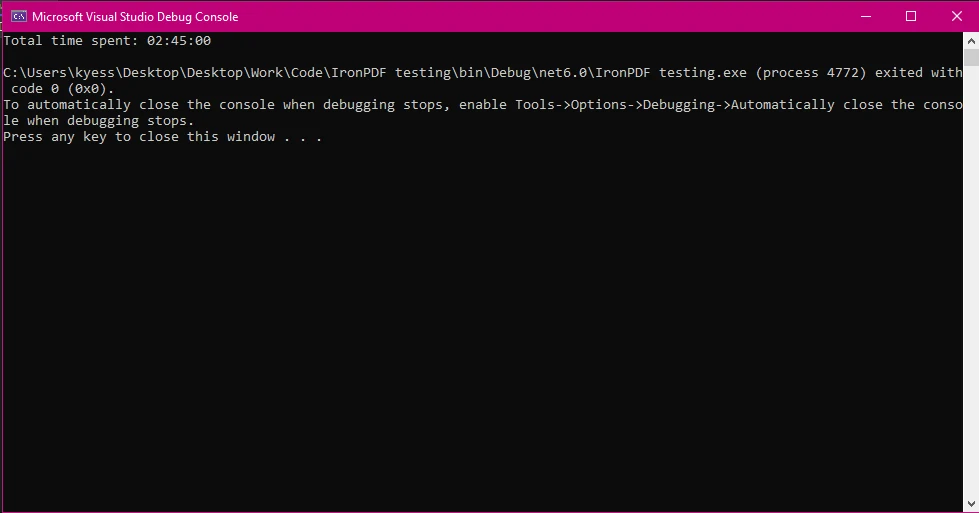
When it comes to displaying TimeSpan values, C# provides several formatting options. Specifier outputs are used to control how TimeSpan values are displayed when converting them to strings. These specifiers define the output format of TimeSpan objects, helping customize their representation in the final PDF report. The most commonly used format specifiers include:
Here are examples of formatting TimeSpan for output in reports or logs:
TimeSpan duration = new TimeSpan(1, 2, 30, 45); // 1 day, 2 hours, 30 minutes, 45 seconds
// Default"c" format strings produce the output: 1.02:30:45
Console.WriteLine(duration.ToString("c"));
// Custom format "hh:mm:ss" outputs: 26:30:45
Console.WriteLine(duration.ToString(@"hh\:mm\:ss"));
// Custom format with days, outputs: 1d 02h 30m
Console.WriteLine(duration.ToString(@"d'd 'hh'h 'mm'm '"));TimeSpan duration = new TimeSpan(1, 2, 30, 45); // 1 day, 2 hours, 30 minutes, 45 seconds
// Default"c" format strings produce the output: 1.02:30:45
Console.WriteLine(duration.ToString("c"));
// Custom format "hh:mm:ss" outputs: 26:30:45
Console.WriteLine(duration.ToString(@"hh\:mm\:ss"));
// Custom format with days, outputs: 1d 02h 30m
Console.WriteLine(duration.ToString(@"d'd 'hh'h 'mm'm '"));Dim duration As New TimeSpan(1, 2, 30, 45) ' 1 day, 2 hours, 30 minutes, 45 seconds
' Default"c" format strings produce the output: 1.02:30:45
Console.WriteLine(duration.ToString("c"))
' Custom format "hh:mm:ss" outputs: 26:30:45
Console.WriteLine(duration.ToString("hh\:mm\:ss"))
' Custom format with days, outputs: 1d 02h 30m
Console.WriteLine(duration.ToString("d'd 'hh'h 'mm'm '"))This example displays the following output:
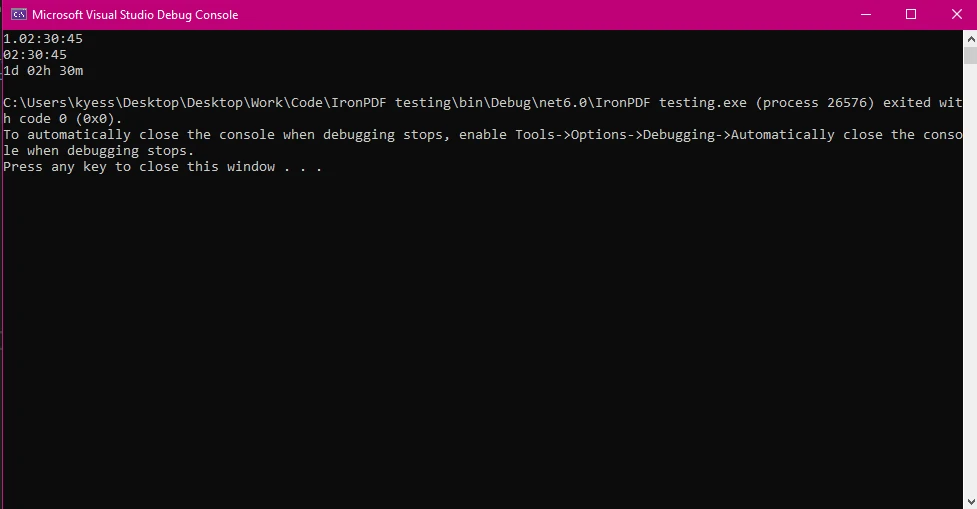
To start using IronPDF, you will first need to install it. If it's already installed, then you can skip to the next section, otherwise, the following steps cover how to install the IronPDF library.
To install IronPDF using the NuGet Package Manager Console, open Visual Studio and navigate to the Package Manager Console. Then run the following command:
Install-Package IronPdfInstall-Package IronPdf'INSTANT VB TODO TASK: The following line uses invalid syntax:
'Install-Package IronPdfOpening Visual Studio, go to "tools -> NuGet Package Manager -> Manage NuGet Packages for Solution" and search for IronPDF. From here, all you need to do is select your project and click "Install" and IronPDF will be added to your project.
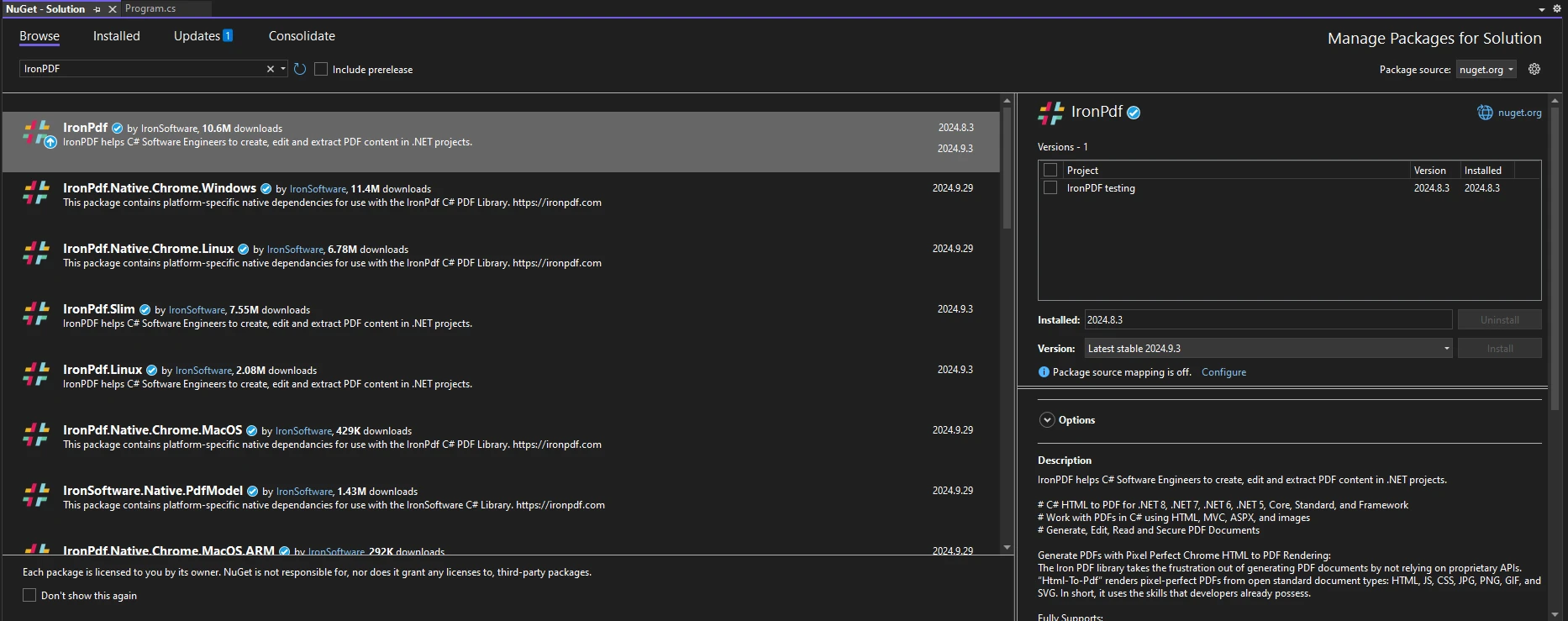
Once you have installed IronPDF, all you need to add to start using IronPDF is the correct using statement at the top of your code:
using IronPdf;using IronPdf;Imports IronPdfNow you're ready to start using IronPDF and TimeSpan for PDF generation tasks.
Once IronPDF is set up, you can use TimeSpan data to generate informative PDF reports. For example, consider a scenario where you need to generate work logs for employees. You can utilize TimeSpan values to display task durations and break times effectively.
Here’s how to use TimeSpan data in a PDF report, including generating a simple work log:
using IronPdf;
public static void Main(string[] args)
{
TimeSpan duration = new TimeSpan(9, 30, 25);
var employees = new List<(string name, TimeSpan timeSpan)> {
("Jane Doe", duration),
("John Doe", duration)
};
GenerateWorkLogReport(employees);
}
public static void GenerateWorkLogReport(List<(string Employee, TimeSpan Duration)> workLogs)
{
ChromePdfRenderer renderer = new ChromePdfRenderer();
var htmlContent = "<h1>Work Log Report</h1><table border='1'><tr><th>Employee</th><th>Duration</th></tr>";
foreach (var log in workLogs)
{
htmlContent += $"<tr><td>{log.Employee}</td><td>{log.Duration.ToString(@"hh\:mm\:ss")}</td></tr>";
}
htmlContent += "</table>";
var pdf = renderer.RenderHtmlAsPdf(htmlContent);
pdf.SaveAs("WorkLogReport.pdf");
}using IronPdf;
public static void Main(string[] args)
{
TimeSpan duration = new TimeSpan(9, 30, 25);
var employees = new List<(string name, TimeSpan timeSpan)> {
("Jane Doe", duration),
("John Doe", duration)
};
GenerateWorkLogReport(employees);
}
public static void GenerateWorkLogReport(List<(string Employee, TimeSpan Duration)> workLogs)
{
ChromePdfRenderer renderer = new ChromePdfRenderer();
var htmlContent = "<h1>Work Log Report</h1><table border='1'><tr><th>Employee</th><th>Duration</th></tr>";
foreach (var log in workLogs)
{
htmlContent += $"<tr><td>{log.Employee}</td><td>{log.Duration.ToString(@"hh\:mm\:ss")}</td></tr>";
}
htmlContent += "</table>";
var pdf = renderer.RenderHtmlAsPdf(htmlContent);
pdf.SaveAs("WorkLogReport.pdf");
}Imports IronPdf
Public Shared Sub Main(ByVal args() As String)
Dim duration As New TimeSpan(9, 30, 25)
Dim employees = New List(Of (name As String, timeSpan As TimeSpan)) From {("Jane Doe", duration), ("John Doe", duration)}
GenerateWorkLogReport(employees)
End Sub
Public Shared Sub GenerateWorkLogReport(ByVal workLogs As List(Of (Employee As String, Duration As TimeSpan)))
Dim renderer As New ChromePdfRenderer()
Dim htmlContent = "<h1>Work Log Report</h1><table border='1'><tr><th>Employee</th><th>Duration</th></tr>"
For Each log In workLogs
htmlContent &= $"<tr><td>{log.Employee}</td><td>{log.Duration.ToString("hh\:mm\:ss")}</td></tr>"
Next log
htmlContent &= "</table>"
Dim pdf = renderer.RenderHtmlAsPdf(htmlContent)
pdf.SaveAs("WorkLogReport.pdf")
End Sub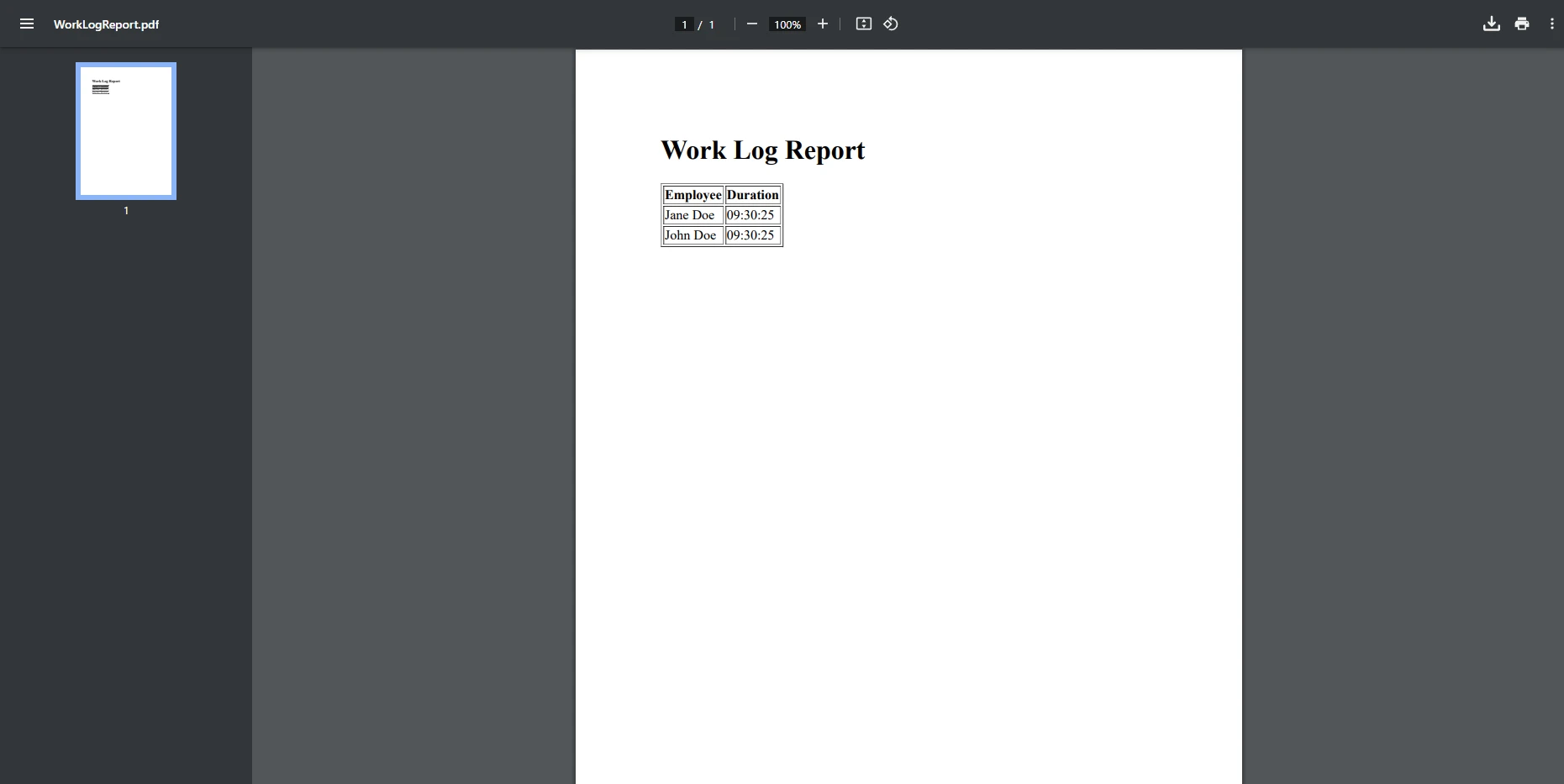
In this example, we’ve created a simple table to display employee work logs. The GenerateWorkLogReport method generates an HTML table with formatted TimeSpan values, which is then converted to a PDF document. We use IronPDF's ChromePdfRenderer class to handle the rendering of the HTML content into a PDF format. PdfDocument is used to create the PDF object used to handle the newly created PDF and save it.
Customizing TimeSpan output can significantly enhance the readability of your reports. For instance, if you only need to display hours and minutes, you can format your TimeSpan accordingly. In this example, we will take the same employee data we created in the last example, and format the TimeSpan to only show the hours and minutes they worked. The seconds aren't necessary for records in this scenario and simply take up unnecessary space so we'll format them out:
using IronPdf;
class Program
{
public static void Main(string[] args)
{
TimeSpan duration = new TimeSpan(9, 30, 25);
var employees = new List<(string name, TimeSpan timeSpan)> {
("Jane Doe", duration),
("John Doe", duration)
};
GenerateWorkLogReport(employees);
}
public static void GenerateWorkLogReport(List<(string Employee, TimeSpan Duration)> workLogs)
{
ChromePdfRenderer renderer = new ChromePdfRenderer();
var htmlContent = "<h1>Work Log Report</h1><table border='1'><tr><th>Employee</th><th>Duration</th></tr>";
foreach (var log in workLogs)
{
// custom format string to format the TimeSpan value for display
string formattedDuration = log.Duration.ToString(@"hh\:mm");
htmlContent += $"<tr><td>{log.Employee}</td><td>{formattedDuration}</td></tr>";
}
htmlContent += "</table>";
var pdf = renderer.RenderHtmlAsPdf(htmlContent);
pdf.SaveAs("WorkLogReport.pdf");
}
}using IronPdf;
class Program
{
public static void Main(string[] args)
{
TimeSpan duration = new TimeSpan(9, 30, 25);
var employees = new List<(string name, TimeSpan timeSpan)> {
("Jane Doe", duration),
("John Doe", duration)
};
GenerateWorkLogReport(employees);
}
public static void GenerateWorkLogReport(List<(string Employee, TimeSpan Duration)> workLogs)
{
ChromePdfRenderer renderer = new ChromePdfRenderer();
var htmlContent = "<h1>Work Log Report</h1><table border='1'><tr><th>Employee</th><th>Duration</th></tr>";
foreach (var log in workLogs)
{
// custom format string to format the TimeSpan value for display
string formattedDuration = log.Duration.ToString(@"hh\:mm");
htmlContent += $"<tr><td>{log.Employee}</td><td>{formattedDuration}</td></tr>";
}
htmlContent += "</table>";
var pdf = renderer.RenderHtmlAsPdf(htmlContent);
pdf.SaveAs("WorkLogReport.pdf");
}
}Imports IronPdf
Friend Class Program
Public Shared Sub Main(ByVal args() As String)
Dim duration As New TimeSpan(9, 30, 25)
Dim employees = New List(Of (name As String, timeSpan As TimeSpan)) From {("Jane Doe", duration), ("John Doe", duration)}
GenerateWorkLogReport(employees)
End Sub
Public Shared Sub GenerateWorkLogReport(ByVal workLogs As List(Of (Employee As String, Duration As TimeSpan)))
Dim renderer As New ChromePdfRenderer()
Dim htmlContent = "<h1>Work Log Report</h1><table border='1'><tr><th>Employee</th><th>Duration</th></tr>"
For Each log In workLogs
' custom format string to format the TimeSpan value for display
Dim formattedDuration As String = log.Duration.ToString("hh\:mm")
htmlContent &= $"<tr><td>{log.Employee}</td><td>{formattedDuration}</td></tr>"
Next log
htmlContent &= "</table>"
Dim pdf = renderer.RenderHtmlAsPdf(htmlContent)
pdf.SaveAs("WorkLogReport.pdf")
End Sub
End Class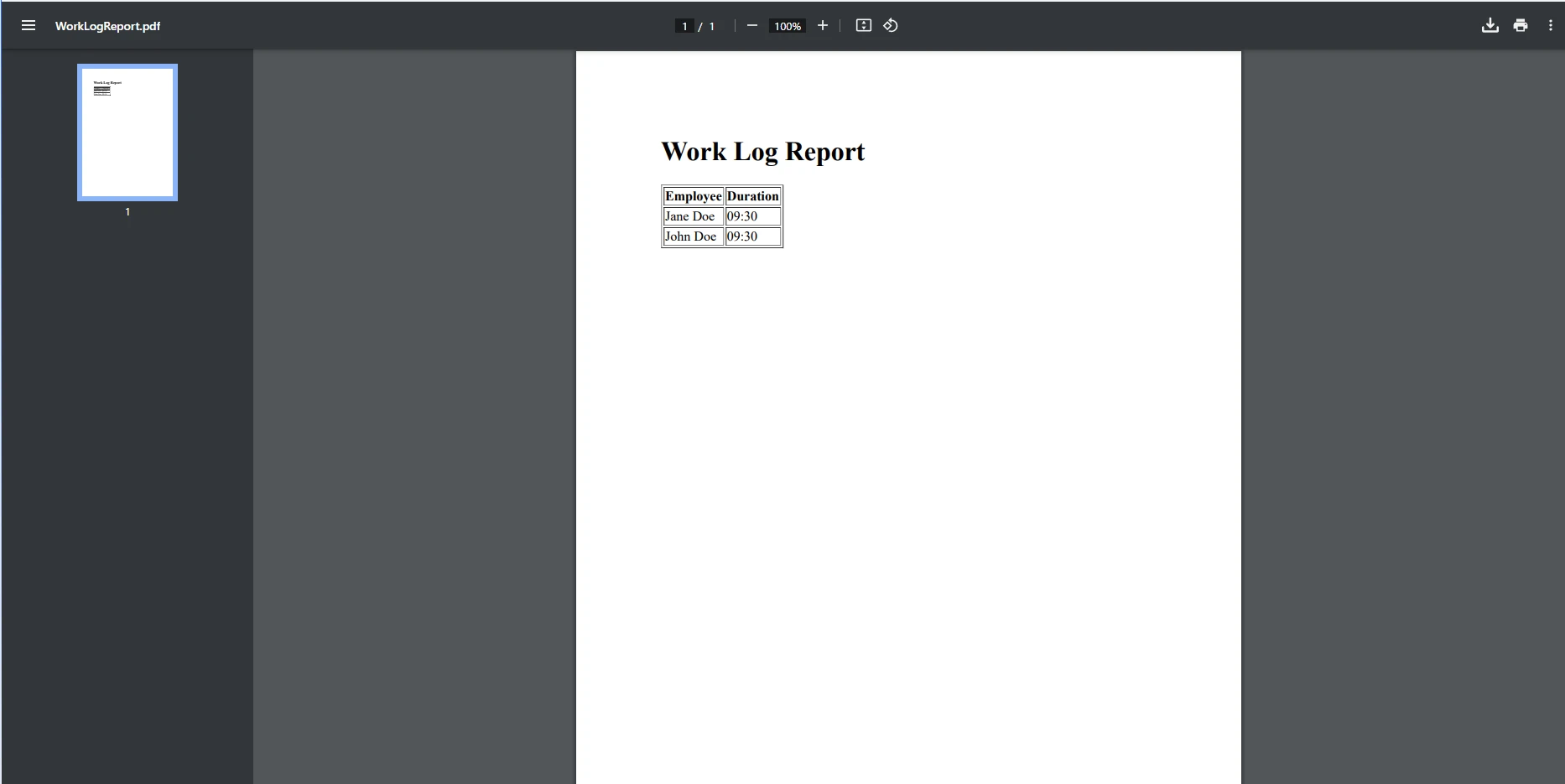
In this example, the ToString(@"hh\:mm\:ss") formats the TimeSpan as 09:3 (total hours and minutes) using custom format strings, however, it should be noted that TimeSpan also supports the use of standard format string types. Using this, you can ensure the TimeSpan is displayed however you desire to maintain document readability. This can also be done backwards, by parsing string into a TimeSpan. Parsing converts input strings that follow a specific format (like "hh:mm" or "d.hh:mm") into an actual TimeSpan object that C# can work with programmatically.
When dealing with larger TimeSpan values, it's important to format them for readability. For instance, you can convert long durations into a more understandable format, such as "3 days, 5 hours":
class Program
{
public static void Main(string[] args)
{
// Sample data: List of employee names and their work durations (TimeSpan)
var workLogs = new List<(string Employee, TimeSpan Duration)>
{
("Alice", new TimeSpan(5, 30, 0)), // 5 hours, 30 minutes
("Bob", new TimeSpan(3, 15, 0)), // 3 hours, 15 minutes
("Charlie", new TimeSpan(7, 45, 0)) // 7 hours, 45 minutes
};
// Create the HTML content for the PDF report
string htmlContent = @"
<h1>Work Log Report</h1>
<table border='1' cellpadding='5' cellspacing='0'>
<tr>
<th>Employee</th>
<th>Work Duration (hh:mm:ss)</th>
</tr>";
// Loop through the work logs and add rows to the table
foreach (var log in workLogs)
{
string formattedDuration = FormatLargeTimeSpan(log.Duration); // Custom method to format large TimeSpan values
htmlContent += $"<tr><td>{log.Employee}</td><td>{formattedDuration}</td></tr>";
}
// Close the HTML table
htmlContent += "</table>";
// Create a new HtmlToPdf renderer
ChromePdfRenderer renderer = new ChromePdfRenderer();
// Render the HTML content as a PDF
PdfDocument pdf = renderer.RenderHtmlAsPdf(htmlContent);
// Save the PDF to a file
pdf.SaveAs("WorkLogReport.pdf");
}
// Custom method to handle the formatting operation
static string FormatLargeTimeSpan(TimeSpan timeSpan)
{
// Check if there are days in the TimeSpan and format accordingly
if (timeSpan.TotalDays >= 1)
{
return string.Format("{0} days, {1} hours, {2} minutes",
(int)timeSpan.TotalDays,
timeSpan.Hours,
timeSpan.Minutes);
}
else
{
// If the duration is less than a day, show only hours and minutes
return string.Format("{0} hours, {1} minutes", timeSpan.Hours, timeSpan.Minutes);
}
}
}class Program
{
public static void Main(string[] args)
{
// Sample data: List of employee names and their work durations (TimeSpan)
var workLogs = new List<(string Employee, TimeSpan Duration)>
{
("Alice", new TimeSpan(5, 30, 0)), // 5 hours, 30 minutes
("Bob", new TimeSpan(3, 15, 0)), // 3 hours, 15 minutes
("Charlie", new TimeSpan(7, 45, 0)) // 7 hours, 45 minutes
};
// Create the HTML content for the PDF report
string htmlContent = @"
<h1>Work Log Report</h1>
<table border='1' cellpadding='5' cellspacing='0'>
<tr>
<th>Employee</th>
<th>Work Duration (hh:mm:ss)</th>
</tr>";
// Loop through the work logs and add rows to the table
foreach (var log in workLogs)
{
string formattedDuration = FormatLargeTimeSpan(log.Duration); // Custom method to format large TimeSpan values
htmlContent += $"<tr><td>{log.Employee}</td><td>{formattedDuration}</td></tr>";
}
// Close the HTML table
htmlContent += "</table>";
// Create a new HtmlToPdf renderer
ChromePdfRenderer renderer = new ChromePdfRenderer();
// Render the HTML content as a PDF
PdfDocument pdf = renderer.RenderHtmlAsPdf(htmlContent);
// Save the PDF to a file
pdf.SaveAs("WorkLogReport.pdf");
}
// Custom method to handle the formatting operation
static string FormatLargeTimeSpan(TimeSpan timeSpan)
{
// Check if there are days in the TimeSpan and format accordingly
if (timeSpan.TotalDays >= 1)
{
return string.Format("{0} days, {1} hours, {2} minutes",
(int)timeSpan.TotalDays,
timeSpan.Hours,
timeSpan.Minutes);
}
else
{
// If the duration is less than a day, show only hours and minutes
return string.Format("{0} hours, {1} minutes", timeSpan.Hours, timeSpan.Minutes);
}
}
}Imports System
Friend Class Program
Public Shared Sub Main(ByVal args() As String)
' Sample data: List of employee names and their work durations (TimeSpan)
Dim workLogs = New List(Of (Employee As String, Duration As TimeSpan)) From {("Alice", New TimeSpan(5, 30, 0)), ("Bob", New TimeSpan(3, 15, 0)), ("Charlie", New TimeSpan(7, 45, 0))}
' Create the HTML content for the PDF report
Dim htmlContent As String = "
<h1>Work Log Report</h1>
<table border='1' cellpadding='5' cellspacing='0'>
<tr>
<th>Employee</th>
<th>Work Duration (hh:mm:ss)</th>
</tr>"
' Loop through the work logs and add rows to the table
For Each log In workLogs
Dim formattedDuration As String = FormatLargeTimeSpan(log.Duration) ' Custom method to format large TimeSpan values
htmlContent &= $"<tr><td>{log.Employee}</td><td>{formattedDuration}</td></tr>"
Next log
' Close the HTML table
htmlContent &= "</table>"
' Create a new HtmlToPdf renderer
Dim renderer As New ChromePdfRenderer()
' Render the HTML content as a PDF
Dim pdf As PdfDocument = renderer.RenderHtmlAsPdf(htmlContent)
' Save the PDF to a file
pdf.SaveAs("WorkLogReport.pdf")
End Sub
' Custom method to handle the formatting operation
Private Shared Function FormatLargeTimeSpan(ByVal timeSpan As TimeSpan) As String
' Check if there are days in the TimeSpan and format accordingly
If timeSpan.TotalDays >= 1 Then
Return String.Format("{0} days, {1} hours, {2} minutes", CInt(Math.Truncate(timeSpan.TotalDays)), timeSpan.Hours, timeSpan.Minutes)
Else
' If the duration is less than a day, show only hours and minutes
Return String.Format("{0} hours, {1} minutes", timeSpan.Hours, timeSpan.Minutes)
End If
End Function
End Class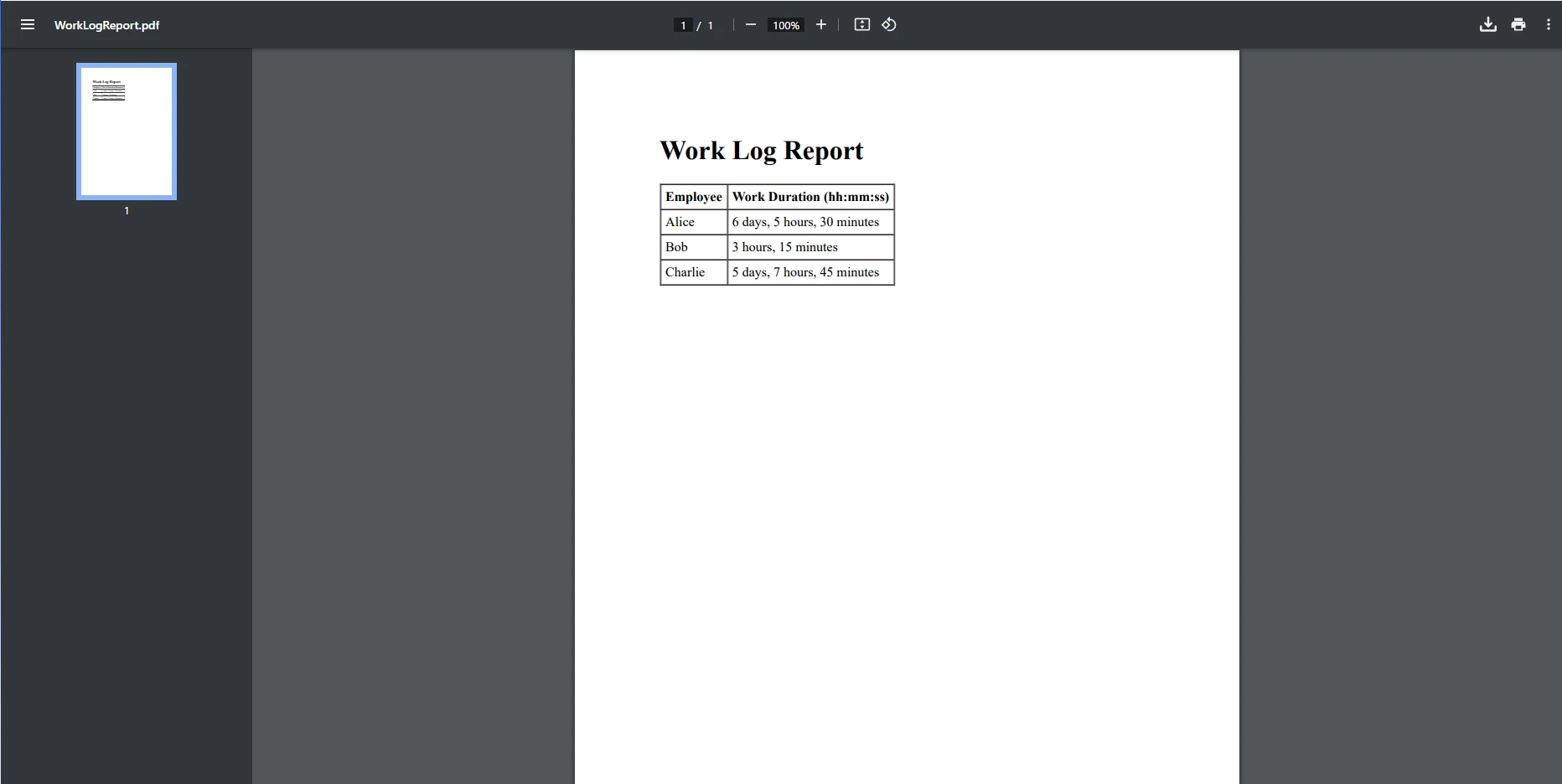
For this example, the custom method FormatLargeTimeSpan converts large TimeSpan values into easily readable formats, such as "6 days, 5 hours, 30 minutes." It checks whether the TimeSpan value includes days and formats the output accordingly, using methods that support composite formatting.
IronPDF stands out for its robust features in generating dynamic PDFs based on string, time, and HTML data. With IronPDF, your PDF-related tasks will become a breeze to handle. From basic PDF generation to secure PDF encryption, IronPDF has you covered. Some key benefits include:
IronPDF integrates seamlessly with .NET applications, allowing developers to leverage the TimeSpan structure effectively. With IronPDF, you can generate professional reports that include formatted time data with minimal effort, making your reporting process efficient and straightforward.
In this article, we explored how to format and handle TimeSpan values in C# and seamlessly integrate them into IronPDF to generate dynamic time-based reports. The C# TimeSpan format structure is an essential tool for representing time intervals, such as project durations, work logs, and task completion times. Whether you're dealing with short time spans or large intervals that span several days, hours, and minutes, C# provides flexible formatting options to present this data in a human-readable format. Moving on to more advanced examples could include following formatting conventions for cultures, taking time inputs, parsing strings into a TimeSpan, and so on.
IronPDF excels in converting HTML to PDF with precision, making it the ideal tool for generating reports from data-driven applications. Its integration with C# makes it easy to incorporate complex structures like TimeSpan into high-quality PDFs.
Now that you understand how to format TimeSpan values and integrate them into PDF reports using IronPDF, it's time to take the next step. Download a free trial of IronPDF and explore its full potential in generating dynamic, data-driven reports for your projects. With IronPDF, you can transform your time-based data into polished, professional documents with minimal effort.